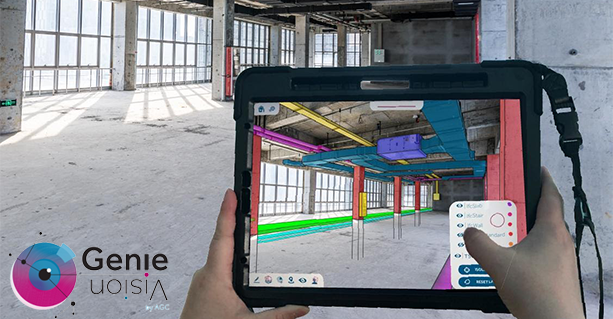In 2018, AGC hosted a boot camp in order to push innovation through people with new ideas. After a 6-month process, presenting to angel investors and business angels, AGC decided to invest in GenieVision, a SaaS Solution overlaying a 3D augmented reality model, correctly placing on to of on-going site works. While some organizations and institutions still have their reservations against BIM, there also are several key factors that can push BIM forward.
Speaking to one of GenieVision’s Co-founders and the COO, Caroline Zigrand, she explains: the first fundamental factor is the availability of high-level quality education and practical information for the incoming generation of expertise. Second, in order to increase the quality of digital skills, the fundamental role of the industry’s association is to spread the best practice in terms of digitization of the construction sector. Third, the actors in the industry should increase the interoperability between the diverse set of construction software, by a common language between the actors of our industry, such as buildingSMART. This is only achievable when software companies working towards attaining a common goal to build a comprehensive digital platform, supported by open innovation and interoperability.
Another challenge they witness is the diverse levels of BIM maturity between different countries. Therefore, public authorities play a fundamental role in the adoption of BIM. For example, the Anglo-Saxon countries are doing well relative to other countries, as well as, pushing a bottom-up approach through local associations such as in France with the Plan BIM2022.
While all of the above is crucial for the advancement of BIM adoption, a general common action or regulation is to see the AEC industry leaders willing to call-for-action among all stakeholders to invest. Fundamentally, several industry actors agree that if there is a single BIM language that is utilized by either a contractor, designer or architect, the project team will have better visuals, less project lag, less waste, more efficient building methods and post-construction facility maintenance.
The big challenge in the coming months and years will be indeed to gather all the stakeholders of a project around one single model, where there will be interaction between the design and between the data related to the design. While we are not there yet, the future looks promising and for sure the stream is going to do that. Some explain that the reason behind the market’s high expectations is that big players such as Autodesk, for example, are putting a lot of effort to build this kind of ecosystem where all the players can quite easily connect themselves together around one single model, depending on their own needs.
However, there is also this stream of players that prefer to do things differently, but still want to operate using the same language, the same standards, in terms of exchanging data, and so on. Whist, for sure this is expected take more time, it’s suitable for smaller companies for will need support or the speed up of BIM adoption. Hence, indeed, it must be supported by qualified team and have adequate tools to optimize the process. Nevertheless, BIM can help from construction logistic to purchasing, be involved in the planning and sequencing of the construction site, collaborating around design, by helping streamline the workflows between design, planning and execution and the communication between build and owner stakeholder groups. Therefore, there is a common understanding of what it’s necessary to do to optimize the entire value chain of a project. It’s not a one-shot action rather part of a learning curve.
GenieVision remains true to their value proposition that was initiated two years ago: “to exist as a core product that is really useful for the customer”. Their key action is to make sure that GenieVision is built to be interconnected to other software tools. In other words, GenieVision builds their solution on open architecture, that allow them to be connected to create API connection with other systems, and just be part of the ecosystem the customer would like to build.
On top of that, there are countries which are much more organized. For example, in Holland, the public authorities are ready to inform the different players in the industry, the necessity to adopt BIM in each of their prospect projects. For other country, it’s not really the case. This is probably how countries are organized, how the secretaries organized, and also the reaction that they have towards these requests of putting BIM in place.
The ambition for GenieVision is to help optimize BIM. Built their solution based on an open architecture, they are able to create connector/API with customer’s third-party ecosystem. The idea is quite simple: “focus on what we can do, on our core product – Be the visual interface of BIM on site – and let the other process be handled by what customer is already using”. This way GV saves a lot of time, for their customers, avoiding duplicate work and additional complexity.
This is true when the challenge around the 3D model is done, they can optimize the design and use it on the execution site. Caroline goes further to say: the process first, during the design phase, is to check for clash detection, making sure that everything is confirmed to what is needed to build. Then they implement their work on site, bringing the 3D model in their solution and displaying on top of the reality. GenieVision wants to take this a step further, to display a visual interface and display data to all digital assets of a project.
To speed up the process of the contractor and make sure there is a coordination between all the stakeholders around one single truth, which is the visual, we need to make sure that we can rely on the 3Ds.
Furthermore, when asked about the lack of investments, Caroline says that because BIM can be something new and maybe because it probably will take time for subsequent subcontractors to align their 3D and to input data to a 3D model for which they will not get any use of it, we see the difference investments. There really has to be a change management to be done to allow them to recognize the added value.
Nevertheless, there is an investment in terms of getting the right resource to work correctly, and also an action from the promoter on the owner of the project to push for that into the work process. It’s important to highlight the unique selling proposition of BIM. It is a system that each company can use to support their own unique selling point.
This is why there should be a standardized language. There are two ways to go further. The first way is to work with an all-in-one platform-based system, for example Autodesk. Second, you have to promote the interoperability and have an open-source system, which allows for a different solution to easily talk together. Caroline continues to say: “for sure that the two trends will remain, because some actors will not want to go with such big players than they would like to keep the smaller structure more agile and they would like to use software developing their own needs”. For that to happen, they need to make sure that there is an intellectual interoperability to speak together.
What’s in store for GenieVision’s future?
Zigrand says: “What we do today, is focusing on the construction part and really helping general contractors and engineering offices monitor their site through the 3D model and let them save time and cost, while increasing the quality of their projects”.
She continues: “Tomorrow, has two plans. First, from the application perspective, we would like to add new layers, some features that will really push our product to a kind of end, which is the exploration and the exploitation of the management of the data”. In other words, GenieVision wants to bring data on top of the 3D object on site. “GenieVision is also looking to expand their scope of customers. That is currently in process by talking to maintenance and operation, as well as, talking to also industry leaders who also will benefit from their product”.
Their big challenge is to make sure they handled perfectly every technology linked to the solution for the good use of the operator on site.
Finally, GenieVision is now focusing on Benelux and France. There is a plan to expand to Germany, and also other European countries such as UK, Spain, Italy and others countries.

Project Manager

